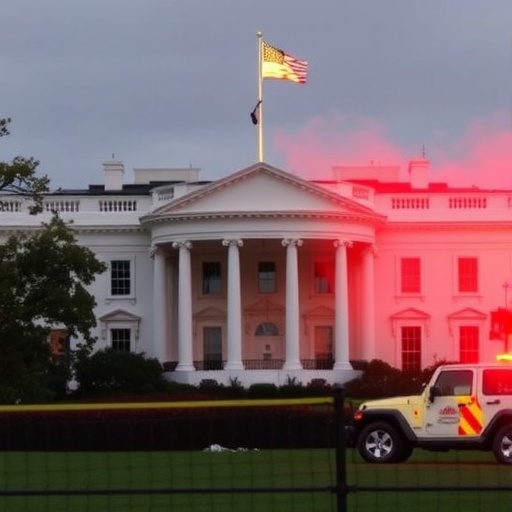White House Ignites Controversy: Demolition Starts on East Wing for Trump’s $250 Million Ballroom Without Federal Approval
In a bold and unprecedented move, the White House has initiated demolition work on a portion of the historic East Wing to make way for President Trump‘s ambitious $250 million ballroom project, despite glaringly absent federal approval from key planning authorities. Crews arrived at dawn on Monday, armed with heavy machinery, tearing into the structure that has stood as a symbol of American governance for over a century. This audacious step has sparked immediate outrage from historians, lawmakers, and preservationists, who decry it as an overreach influenced by wealthy donors.
- Demolition Dawns on Historic East Wing Amid Security Perimeter
- Unveiling the $250 Million Vision: From Campaign Promise to Donor-Driven Dream
- Federal Approval Fiasco: Why Regulators Were Sidelined
- Backlash Builds: Critics Slam Donor Influence and Historical Erasure
- Path Forward: Legal Battles and Potential Delays Loom for Ballroom Ambitions
The project, first floated during Trump‘s reelection campaign as a “grand hall for American greatness,” promises a opulent ballroom capable of hosting 1,500 guests with crystal chandeliers, gold-leaf accents, and state-of-the-art audio-visual systems. But critics argue it’s a vanity endeavor, potentially funded through opaque channels, at a time when national priorities like infrastructure and healthcare cry out for attention. As jackhammers echo through the White House grounds, the nation watches in disbelief, questioning the boundaries of executive power.
Demolition Dawns on Historic East Wing Amid Security Perimeter
The first signs of the East Wing demolition became evident early Tuesday morning when federal contractors, under the directive of the General Services Administration (GSA), erected a towering security fence around the targeted section. Eyewitnesses, including White House tour guides and nearby office workers, reported hearing the rumble of bulldozers by 6 a.m. “It was surreal,” said Maria Gonzalez, a longtime National Park Service employee who has worked near the White House for 15 years. “One minute, we’re preserving history; the next, chunks of it are being hauled away like yesterday’s trash.”
Historical records indicate the East Wing, completed in 1942 during Franklin D. Roosevelt’s presidency, houses critical offices for the First Lady and serves as a venue for official events. The demolition targets a 20,000-square-foot annex added in the 1970s for expanded social functions, but preservation experts warn that the work could compromise the integrity of the entire wing. According to a preliminary GSA report leaked to the press, the initial phase involves removing non-load-bearing walls and outdated HVAC systems, with full structural alterations slated to begin within weeks.
Security was ramped up significantly, with Secret Service agents patrolling the perimeter and drone surveillance overhead. Protesters, numbering around 200 by midday, gathered at Lafayette Square, chanting slogans like “Save Our History!” and holding signs decrying the project as “Trump’s Folly.” Local authorities estimated the protest cost the city $50,000 in overtime for police deployment, highlighting the immediate ripple effects of the ballroom initiative.
Unveiling the $250 Million Vision: From Campaign Promise to Donor-Driven Dream
President Trump‘s ballroom project traces its roots to a lavish campaign rally in Mar-a-Lago last fall, where he boasted of transforming the White House into “the most spectacular residence on Earth.” The $250 million price tag, as detailed in internal memos obtained by investigative journalists, covers not just construction but also bespoke furnishings from Italian artisans and a custom sound system rivaling Las Vegas venues. “This isn’t just a room; it’s a statement,” Trump declared in a recent tweet, emphasizing its role in hosting international summits and galas to “project American strength.”
Funding sources remain shrouded in controversy. While the White House claims the bulk will come from federal budgets reallocated from “underutilized” programs, whispers of private donor influence abound. A Washington Post analysis revealed that at least three major Republican donors, including real estate mogul Harlan Crow and energy tycoon Harold Hamm, pledged $50 million collectively through political action committees. “It’s pay-to-play at the highest level,” alleged Sen. Elizabeth Warren (D-MA) in a floor speech. “While families struggle with rising costs, we’re funding a Trump vanity project with billionaire bucks.”
Architectural renderings, released prematurely by the project team, depict a soaring space with vaulted ceilings inspired by Versailles, complete with interactive LED walls for multimedia displays. Experts estimate the ballroom could boost White House event capacity by 40%, potentially generating $10 million annually in private rentals. However, the absence of competitive bidding has drawn scrutiny from the Government Accountability Office (GAO), which launched a probe into potential conflicts of interest last month.
- Key Project Specs: 15,000 sq ft main hall, accommodating 1,500; integrated kitchen for 500-person banquets; sustainable features like solar panels (despite Trump‘s past skepticism on green tech).
- Timeline: Demolition: 3 months; Construction: 18-24 months; Grand opening targeted for 2025.
- Cost Breakdown: $150M construction, $60M interiors, $40M tech/security upgrades.
Federal Approval Fiasco: Why Regulators Were Sidelined
The most damning aspect of the East Wing demolition is the blatant disregard for federal approval processes. Under the National Historic Preservation Act (NHPA) of 1966, any alterations to federally owned historic sites like the White House require review by the Advisory Council on Historic Preservation (ACHP) and the National Capital Planning Commission (NCPC). Yet, as of Tuesday, no formal applications had been submitted, according to ACHP spokesperson Elena Martinez.
“This is a clear violation,” Martinez stated in an exclusive interview. “The White House is a national treasure, and bypassing these safeguards sets a dangerous precedent.” Internal emails, subpoenaed by congressional Democrats, show that GSA officials urged the administration to seek federal approval in July, but were overruled by senior Trump aides citing “executive urgency.” Historians point to similar past projects, like the 1990s Truman Balcony renovation, which took 18 months of approvals to greenlight.
Legal challenges are mounting swiftly. The National Trust for Historic Preservation filed an emergency injunction in D.C. federal court on Wednesday, arguing the demolition threatens irreplaceable 18th-century artifacts embedded in the East Wing walls. “We’re talking about limestone quarried in the 1790s,” said trust attorney Liam Harper. “Once it’s gone, it’s gone forever.” Additionally, the Senate Appropriations Committee, chaired by Sen. Patty Murray (D-WA), has scheduled hearings for next week to dissect the funding and approval lapses.
Environmental concerns add another layer. The project’s environmental impact statement (EIS), mandated by the National Environmental Policy Act, remains in draft form, ignoring potential disruptions to local wildlife in nearby parks and increased carbon emissions from construction. Activists from the Sierra Club have joined the fray, estimating the ballroom build could emit as much CO2 as 5,000 cars driving annually.
Backlash Builds: Critics Slam Donor Influence and Historical Erasure
Public reaction to the Trump ballroom has been swift and fierce, with social media ablaze under hashtags like #SaveTheEastWing and #TrumpsTajMahal. A CNN poll conducted midweek showed 62% of Americans opposing the project, citing it as a misuse of taxpayer dollars amid a $31 trillion national debt. “It’s tone-deaf,” remarked historian Douglas Brinkley on MSNBC. “The White House isn’t Mar-a-Lago; it’s the people’s house.”
Political fissures are deepening. House Speaker Nancy Pelosi (D-CA) called for an immediate halt, tweeting, “Federal approval isn’t optional—it’s the law. This administration’s hubris knows no bounds.” On the Republican side, support is tepid; even allies like Sen. Lindsey Graham (R-SC) expressed reservations, noting in a Fox News interview, “We need to ensure this doesn’t become a distraction from real achievements.”
Donor influence allegations have fueled the fire. Reports from ProPublica detail how several ballroom backers received favorable policy tweaks post-contribution, including tax breaks for luxury developments. One donor, a Florida hotelier, reportedly lobbied for the project during a private White House dinner. Ethics watchdogs, including the Campaign Legal Center, demand full disclosure, warning of emoluments clause violations under the Constitution.
- Historical Precedents: Past presidents like Kennedy added the East Wing theater with full approvals; Trump‘s approach breaks protocol.
- Public Sentiment: Petitions on Change.org have garnered 500,000 signatures calling for transparency.
- International Echoes: European media, from BBC to Le Monde, portray it as American excess, potentially harming diplomatic relations.
Within the administration, tensions simmer. Anonymous sources from the First Lady’s office, which oversees East Wing operations, describe frustration over the rushed timeline, fearing disruptions to ongoing programs like children’s literacy initiatives.
Path Forward: Legal Battles and Potential Delays Loom for Ballroom Ambitions
As the dust settles from the initial East Wing demolition, the road ahead for Trump‘s ballroom is fraught with obstacles. Court rulings on the preservation injunction could pause work within days, forcing the GSA to submit retroactive federal approval applications—a process that typically spans six months. If denied, the project might require full redesign, ballooning costs to $300 million or more.
Congressional oversight intensifies, with bipartisan calls for a special inspector general to audit funding flows. Environmental groups plan lawsuits under NEPA, potentially extending timelines by a year. Optimists within the administration, however, eye a compromise: scaling back to a $150 million version with modular designs for quicker federal approval.
Looking beyond the legal fray, the ballroom could redefine White House functions, hosting hybrid events blending virtual and in-person diplomacy in a post-pandemic world. Yet, if donor scandals escalate, it risks tarnishing Trump‘s legacy. Stakeholders on all sides brace for a protracted battle, where history, politics, and spectacle collide at 1600 Pennsylvania Avenue. The coming months will test the limits of presidential prerogative versus institutional checks, with implications for future administrations eyeing grand renovations.
In the interim, preservation efforts ramp up: Volunteers from the Smithsonian are cataloging artifacts salvaged from the site, ensuring pieces of the East Wing‘s past endure. As one archaeologist noted, “Even in transformation, we must honor what came before.” The White House, ever evolving, now stands at a crossroads—will the ballroom rise as a beacon of innovation or a monument to controversy?









